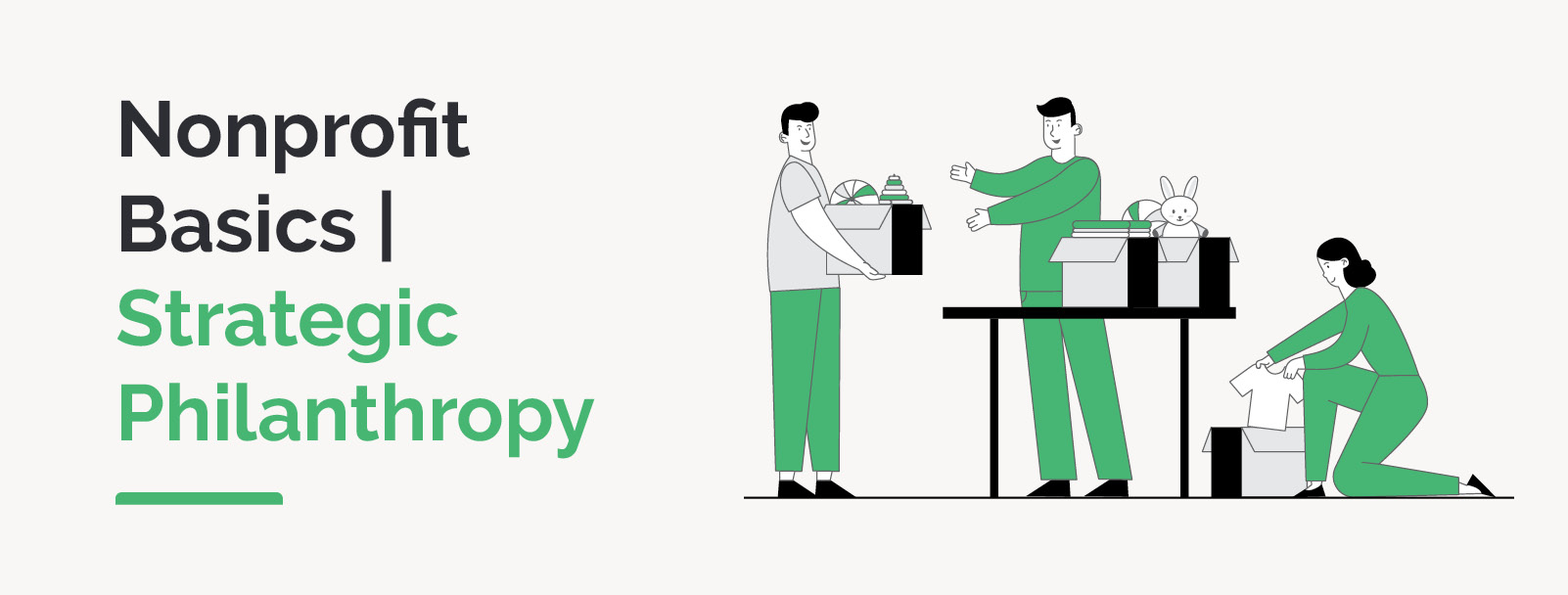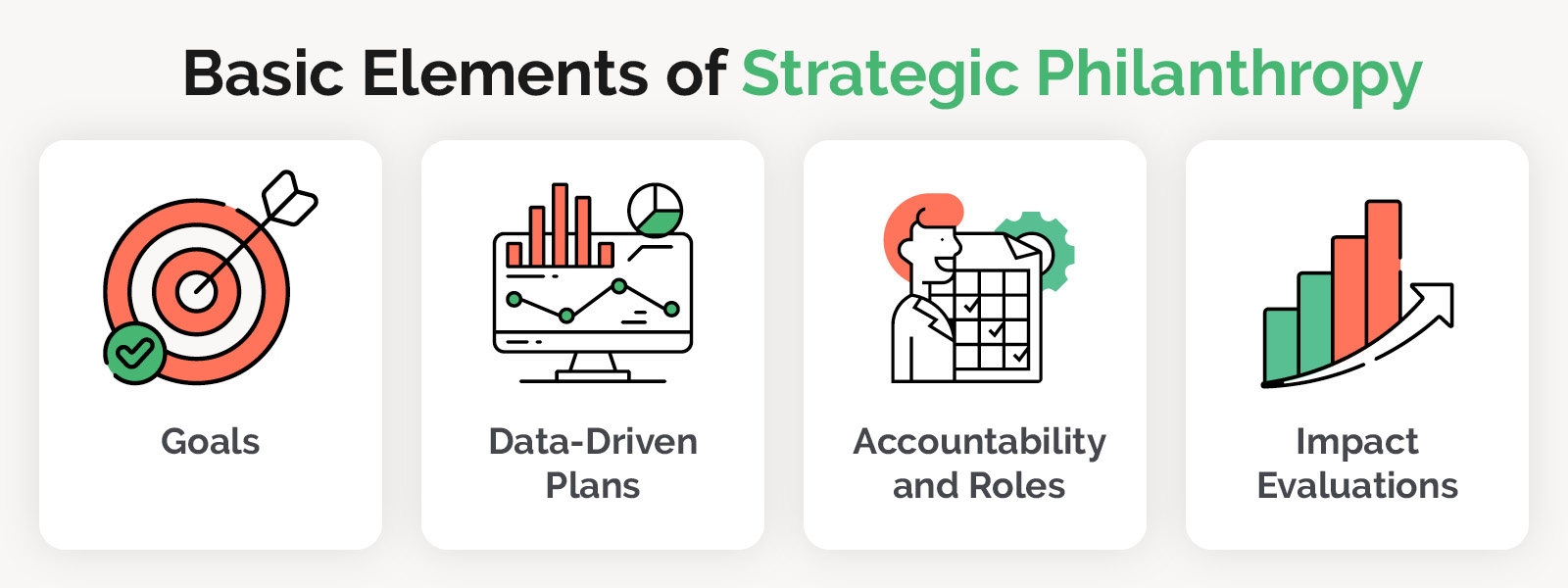Nonprofit Basics: Strategic Philanthropy
A significant amount of time, resources, and effort goes into powering social change.
Many of the problems we strive to address today require well-researched and detailed strategies from a variety of actors in the nonprofit sector. To make sense of this process, funders have turned to the model of strategic philanthropy.
With principles that are simple and straightforward to follow, this model guides charitable organizations toward crafting a strategy for contributing the right funds to the right places in order to further their particular missions.
What is strategic philanthropy?
Strategic philanthropy is a philanthropic model that involves allocating funding to charitable work according to a concrete, overarching strategy in pursuit of a definable mission. For individual donors, charitable foundations, corporations, and governments, this model can serve as an effective basis for determining where to direct their financial support.
Some basic elements of strategic philanthropy include:
- Goals. Strategic philanthropy emphasizes the importance of defining clear, achievable goals that can be referenced when determining budgets for grants or other funds.
- Data-Driven Plans. Research plays a crucial role in this strategy-building process. Philanthropic organizations should have well-established data collection procedures in place to record and measure the outcomes of grants and programs.
- Accountability and Roles. With guidance from in-depth research and data, funders should be able to develop a clear hypothesis for approaching the problem associated with their mission. Roles and financial resources can then be assigned accordingly.
- Impact Evaluations. Outcomes are another significant aspect of the strategic philanthropy model. The strategy cultivated by this model is intended to predict and lead to reaching the organization’s established goals. Collecting and communicating data on the impact of these strategized efforts is essential for informing subsequent funding decisions.
In order to foster a healthy funder-funded relationship, remember to prioritize reporting and communication. Whether you’re interfacing with partners and stakeholders during the funding cycle or conducting a social impact assessment for outcome measurement, sharing metrics will allow you to demonstrate the tangible results of financial contributions.
While strategic philanthropy lays out a reliable framework for social-good organizations to determine how best to allocate their funds, applications of this model have led to several notable critiques. Because of this, many funders are adjusting their approach. Strategic philanthropy is evolving, and for the better.
What are other philanthropic models?
In recent years, several other approaches to philanthropy have come to prominence. The limits and perceived inflexibility of strategic philanthropy have become increasingly visible in many contexts, especially for more dynamic challenges that require changes across an entire system. So what are philanthropic organizations turning to instead?
The spotlight has fallen onto collaboration and communication, ensuring that foundations, nonprofits, and their constituents are well-aligned in their missions, financial strategies, and goals. This includes keeping all stakeholders updated on collected data or potential issues. One particular model that has begun to rise in popularity is emergent philanthropy.
What is emergent philanthropy?
Emergent philanthropy is an approach that emphasizes collaborating with multiple organizations and partners to co-create a strategy that will be refined as it’s applied in order to maximize on-the-ground impact. In response to strategic philanthropy’s fixed predictive model, this model is all about flexibility.
Complex problems in the world of social change require strategies that have the ability to adapt to the many moving parts of a given plan or initiative. Emergent philanthropy acknowledges that generating social progress can be messy and, therefore, leans into the need to regularly modify and communicate changes to strategy based on current needs and past results.
Participatory grantmaking is an inclusive process that has sprouted from the ideas of emergent philanthropy. This practice addresses the problematic disconnect that can often develop between philanthropic organizations and nonprofits while pursuing their predefined objectives. By prioritizing real-time communication of funding impact and potential strategy issues, you’ll be able to stay on the same page with your stakeholders and partners to drive the most effective impact.
What are the critiques of strategic philanthropy?
The model of strategic philanthropy has many merits, especially when it comes to tackling simple and even complicated problems in society. However, when organizations attempt to deal with complex problems, with interventions aimed at systemic change, this logic model becomes limiting.
The basis of strategic philanthropy rests upon a single overarching plan, backed by research, that determines how the stakeholders of a charitable mission make decisions and carry out activities to reach their objectives. Adhering strictly to a predetermined plan becomes increasingly difficult as a multitude of unpredictable factors begins to impact stakeholders at all levels.
Whether you’re working with grantmaking organizations such as a corporation’s philanthropic branch or just interacting with others within your nonprofit, the emergent model’s principles of collaboration and communication attempt to address the challenges that emerge from the complexity of social change.
How is strategic philanthropy evolving?
With the help of updated approaches such as participatory grantmaking, real-time communication, and updated technology, the traditional strategic philanthropy model is evolving into a more adaptive, modernized form.
Many philanthropic organizations and nonprofits have come to realize the need for more flexible approaches to their goals. SureImpact walks through the new philanthropic model of the Siemer Institute, a foundation that effectively adapted its approach to philanthropy through improved communication, data reporting, and software training.
As these innovative practices continue to rise to the forefront of philanthropy, organizations and nonprofits alike will be much better equipped to maximize their social impact.
Other Resources to Explore
Nonprofit Basics – Learn more nonprofit management essentials by exploring other expert resources.
Nonprofit Basics: Nonprofit Accounting – Collecting and sharing data is crucial for your nonprofit’s financial strategy and relationships with donors. Read more about fund accounting essentials in this guide.
Nonprofit Basics: The Donor Pyramid – Discover how to optimize your donor communications and engagement by creating a donor pyramid for your nonprofit.



